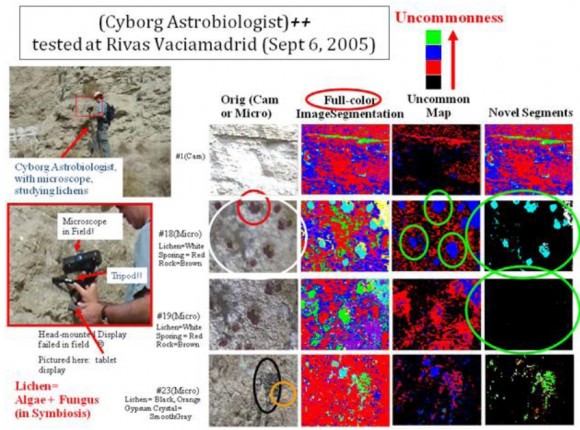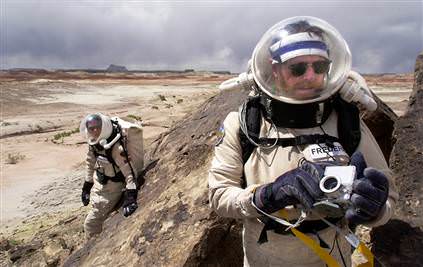Ever heard of a ‘Cyborg Astrobiologist’? Probably not. But I bet you’ll want to be one after learning that future exploration of Mars (and other planets, for that matter) may employ the use of artificial intelligence integrated into spacesuits to enhance the ability of astronauts in taking scientific data while exploring. The AI assistance could help future astronauts exploring planets to recognize differences in their surroundings as being due to the presence of life. Does this sound like something from 50 years from now? Well, a prototype model has already been tested, and has shown the principle behind this idea to be sound.
University of Chicago geoscientist Patrick McGuire and his team have developed the basic systems needed for such a spacesuit, using mostly off-the shelf technology. The system uses a Hopfield neural network to analyze data taken in by a either a camera phone or a microscope. The AI system employs a ‘novelty detection algorithm’ which analyzes images from either imaging device, and is able to identify features in images that are out of place.
The Hopfield system compares patterns against ones it has already seen, and learns from this process to correctly identify novel patterns that could be of interest. The full prototype spacesuit has a wearable computer that houses the AI system, which uses Bluetooth to receive data from a cell phone camera or is connected to a USB digital microscope.
The system was tested at the Mars Desert Research Station (MDRS) in the San Rafael Swell of Utah, which is maintained by the Mars Society. The MDRS is a semi-arid desert with “greenish, grey or light gray mudstone,
limestone, siltstone and sandstone, partially inter-bedded by white sandstone layers”. For the last two weeks of February 2009, two members of McGuire’s team tested the wearable technology, which was able to successfully learn to identify patches of lichen from a background of rock, and identify different color patterns that signified different rock formations.
Another test, conducted in September of 2005 at Rivas Vaciamadrid in Spain, utilized a USB digital microscope to image rocks with lichen on them. As you can see in the image below, the AI system was able to identify as uncommon the spores of the lichen, which are about 1mm in diameter.
There are still some bugs to be worked out, though, as the system detected cast shadows in rough terrain our low standing Sun as novel features, the researchers wrote in their paper, The Cyborg Astrobiologist: Testing a Novelty-Detection Algorithm on Two Mobile Exploration Systems at Rivas Vaciamadrid in Spain and at the Mars Desert Research Station in Utah, available on Arxiv. The researchers also tested a head-mounted digital microscope display, but instead opted for a tripod due to the blurriness associated with the head movement of the researcher wearing the suit.
Though it may be a while until there are any Martian astronauts utilizing such a system – let alone Martian astronauts with the title of ‘Cyborg Astrobiologist’ – the combination of the AI with imaging systems could start to prove very useful on future orbital surveyors of Mars. Additionally, these systems could be used to collect and analyze data outside of the visible light spectrum, which could be incredibly useful for both robotic and human explorers.
Source: Physorg, Arxiv


If we have to send astronauts to Mars, then why not have them wear cybersuits that detect their every motion and that relay digital images and other information to their senses. These are telemetered with robots on Mars. So the astronaut is going through various motions and sees things by this telepresence. If the astronaut in the telepresence module grabs a tool they see, the robot on Mars does exactly the same.
In this case the landing craft can be made small, cutting expense, you have a near real time down link, such as attack drones in Swat velley Pakistan, and you can get the job done. There would be no biocontamination either. There would also be no risk of astronauts being stranded on Mars — well maybe around Mars though.
LC
Very interesting!
Just hope the AI in the suit doesn’t go rogue…just kidding.
cool idea,
Mr. Man
Can anyone say “Metroid Prime Scan Visor”? I can, and in fact I just did 😀
No, seriously, that’s what this reminds me of. It won’t be long before they can detect types of rock and animal and plant species.
Also, IIRC biologists have started to look for luminescence in cyanobacteria, from possible quite general features of photo-active systems.